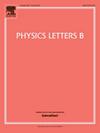Measurement of the neutron total cross section of Iron at the Back-n white neutron source of CSNS
IF 4.3
2区 物理与天体物理
Q1 ASTRONOMY & ASTROPHYSICS
引用次数: 0
Abstract
The neutron total cross section of iron (natFe) plays an important role in the basic science of nuclear physics, nuclear technology and nuclear energy application. A new measurement of the total cross section of iron from 0.3 eV to 150 MeV was carried out in single and double bunch modes by transmission method and time of flight method with multi-cell fast fission ionization chamber (FIC) with 235U and 238U coating materials at the China Spallation Neutron Source (CSNS). Normalized fission counts-neutron energy spectra for sample-in and sample-out states were obtained and superimposed. The Bayesian method was used to eliminate the influence of the double-bunch problem on neutron measurement in the energy region above 10 keV. The transmissions obtained in single bunch and unfolded in double bunch coincided well. From 0.3 eV to 150 MeV, the ratio of most energy points of cross section in single bunch and in double bunch fluctuates within 10 %. In the energy range of 0.3 eV to 10 keV, the experimental results using 20 mm and 40 mm thickness iron samples both agree very well with the evaluated data of JEFF-3.3 and ENDF/B-VIII.0 at most energy points, fluctuating within 3 %. In the energy range of 10 keV to 150 MeV, the results agree well with the evaluated data in terms of values and trends. The main resonance peaks of the total cross section of iron at the energies of 3.94 keV, 6.24 keV, 7.76 keV, 27.9 keV, 52.1 keV, 74.1 keV, 83.9 keV, 141 keV, 170 keV, 188 keV and 386 keV are well represented in our results. The relative uncertainties of the total cross sections using the 40 mm iron sample by FIC-235U are within 2 % at most energy points. In 1.5 MeV-140 MeV region, the relative uncertainties of the total cross section using the 20 mm iron and 40 mm iron samples by FIC-238U are around 2 % and 1 %, respectively. The total cross section results can be used as a reference for nuclear data evaluation.
求助全文
约1分钟内获得全文
求助全文
来源期刊

Physics Letters B
物理-物理:综合
CiteScore
9.10
自引率
6.80%
发文量
647
审稿时长
3 months
期刊介绍:
Physics Letters B ensures the rapid publication of important new results in particle physics, nuclear physics and cosmology. Specialized editors are responsible for contributions in experimental nuclear physics, theoretical nuclear physics, experimental high-energy physics, theoretical high-energy physics, and astrophysics.
 求助内容:
求助内容: 应助结果提醒方式:
应助结果提醒方式:


